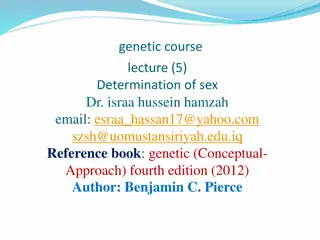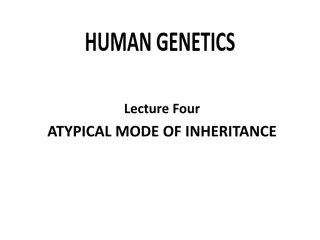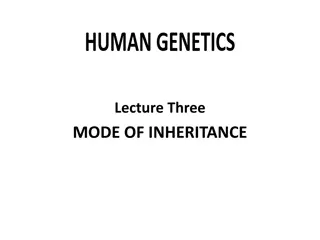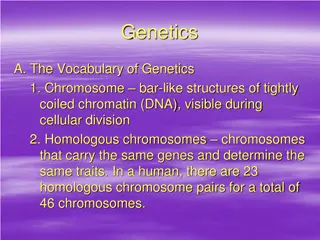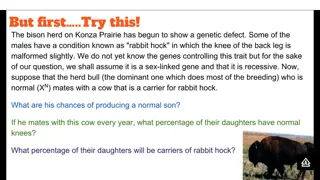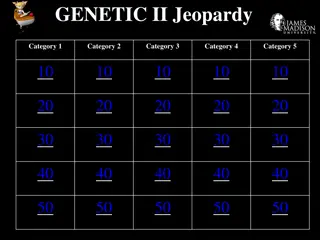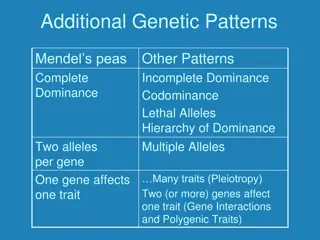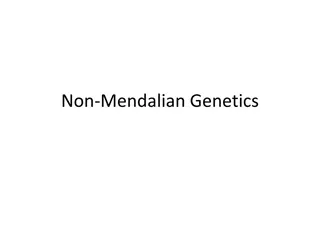Understanding Sex-Linked Inheritance: Key Concepts and Examples
Sex-linked inheritance refers to the transmission of genetic traits determined by genes located on the sex chromosomes. This type of inheritance differs from autosomal inheritance due to the unique characteristics of the X and Y chromosomes. In organisms with XX/XY sex determination, genes on the X chromosome exhibit X-linked inheritance, while genes on the Y chromosome show Y-linked inheritance. Understanding the patterns of inheritance for sex-linked traits is crucial in predicting the likelihood of traits being passed down through generations. Examples of sex-linked traits include hemophilia and color blindness.
Download Presentation

Please find below an Image/Link to download the presentation.
The content on the website is provided AS IS for your information and personal use only. It may not be sold, licensed, or shared on other websites without obtaining consent from the author. Download presentation by click this link. If you encounter any issues during the download, it is possible that the publisher has removed the file from their server.
E N D
Presentation Transcript
genetic course lecture (6) Sex linked inheritance Dr. israa hussein hamzah email: esraa_hassan17@yahoo.com szsh@uomustansiriyah.edu.iq Reference book: genetic (Conceptual- Approach) fourth edition (2012) Author: Benjamin C. Pierce
we learned several basic principles of heredity that Mendel discovered from his crosses among pea plants. A major extension of these Mendelian principles is the pattern of inheritance exhibited by sex-linked characteristics, characteristics determined by genes located on the sex chromosomes. Genes on the X chromosome determine X-linked. characteristics; those on the Y chromosome determine Y-linked characteristics. Becaause the Y chromosome of many organisms contains little genetic information, most sex-linked characteristics are X linked. Males and females differ in their sex chromosomes; so the pattern of inheritance for sex-linked characteristics differs from that exhibited by genes located on autosomal chromosomes. It has been observed that the genes occurring only in the X chromosomes are represented twice in female (because female contains 2X chromosomes) and once in male (because male has only one X chromosome).
The genes which occur exclusively on the X chromosome (mammals, Drosophila, Melandrium, etc.) or on the analogous Z chromosome (in birds and other species with ZO or ZW mechanism of sex determination) are called X- or Z -linked genes. The genes which exclusively occur in Y chromosome are called holandric genes. The inheritance of X- or Z-linked and holandric genes is called sex-linked inheritance. In XX XY type organisms, sex-linked genes can be classified into following three types: A. X-linked. The X-linked type sex-linked inheritance is performed by those genes which are localized in the nonhomologous sections of X- chromosome, and that have no corresponding allele in Y chromosome. The X-linked genes are commonly known as sex-linked genes. B. Y-linked. The Y-linked type sex-linked inheritance is performed by those genes which are localized in the non-homologous section of Y chromosome, and that have no alleles in X-chromosome. The Y-linked genes are commonly known as holandric genes (Greek, holos = whole, and andros = man).
C. XY-linked. The XY linked type sex-linked inheritance is performed by those genes which are localized in homologous sections of X and Y chromosomes Characteristics of Sex-linked Inheritance The characteristics for sex linked inheritance are as follows: a. The pattern of inheritance of sex linked trait is criss-cross. The father passes the X linked allele of a trait to the daughters who pass it on to the grandsons. The father cannot pass a sex linked allele to a son directly. b. The mother can pass the allele of a trait to both daughter and son. c. Only homozygous females can express a recessive trait, while heterozygous female are carriers and do not express the trait. d. Males express the trait immediately because of the absence of a corresponding allele. This is the reason why males suffer from sex linked disorders more than females. e. Most of the sex linked traits are recessive. Some examples of sex linked traits include Haemophilia or Bleeder s disease, Daltinism or Colour blindness
The X-linked genes which exhibit That differential region of each chromosome (i.e., X) contain genes that have no counterparts on the other kind of sex chromosome. These genes, whether dominant or recessive, show their effects in the male phenotype , the types of X- linked genes as followes: 1- The X-linked recessive genes: it show the following two more peculiar features criss-cross pattern of inheritance (i.e., in criss-cross inheritance, a X-linked recessive gene is transmitted from P1male parent (father) to F2 male progeny (grandsons) through its F1 heterozygous females (daughters), which are called carriers) and different F1 and F2 results (ratios) in the reciprocal crosses.The X-linked recessives can be detected in human pedigrees (also in Drosophila) through the following :
(i) The X-linked recessive phenotype is usually found more frequently in the male than in the female. This is because an affected female can result only when both mother and father bear the X-linked recessive allele (e.g., XA Xa XaY), whereas an affected male can result when only the mother carries the gene. Further, if the recessive X-linked gene is very rare, almost all observed cases will occur in males. (ii) Usually none of the offspring of an affected male will be affected, but all his daughters will carry the gene in masked heterozygous condition, so one half of their sons (i.e., grandsons of F1 father) will be affected (iii) None of the sons of an affected male will inherit the X- linked recessive gene, so not only will they be free of the defective phenotype; but they will not pass the gene along to their offspring
XAXA XaY XAY XAY XAXa 1 2 XaY XAY XAXa XAXA Fig. Pedigree showing how X-linked recessive genes are expressed in males, then carried unexpressed by females in the next generation, to be expressed in their sons. II.3 and III.4 heterozygous or carrier females are not distinguished phenotypically
2- Dominant X-linked genes : can be detected in human pedigrees (also in Drosophila) through the following clues : (a) It is more frequently found in the female than in the male of the species. (b) The affected males pass the condition on to all of their daughters but to none of their sons (c) Females usually pass the condition (defective phenotype) on to one-half of their sons and daughters (d) A X-linked dominant gene fails to be transmitted to any son from a mother which did not exhibit the trait itself. In humans, X-linked dominant conditions are relatively rare. One example is hypophosphatemia(vitamin D-resistant rickets). Another example includes hereditary enamel hypoplasia (hypoplastic amelogenesis imperfecta), in which tooth enamel is abnormally thin so that teeth appear small and wear rapidly down to the gums.
XaXa XAY xay XAXa Pedigree chart showing how X-linked dominants are expressed in all the daughters of affected males xa XaY XAXa XaXa XAY XaY Pedigree chart showing that females effected by an X-Linked dominant condition usually heterozygous and pass the condition to one- half of their progeny
Example of Inheritance of X-Linked Recessive Genes The crisscross inheritance of recessive X- linked genes can be well understood by following classical examples in Drosophila, man, moth and chikens etc.: 1. Inheritance of X-Linked Gene for Eye Colour in Drosophila In Drosophila, the gene for white eye colour is Xlinked and recessive to another X-linked,dominant gene for red-eye colour. It is discovered by Morgan in 1910. Following crosses between white eyed and red eyed Drosophila will make clear the characteristic criss-cross inheritance of gene for white eyed color in it :
(a) Red eyed female White eyed male If a wild red eyed female Drosophila is crossed with a mutant white eyed male Drosophila, all the F1 individuals irrespective of their sex have red eyes P XRXR X XrY F1 XRX r , XRY Red eyed female , Red eyed male When the red eyed male and red eyed female individuals of F1 are intercrossed, XRXr X XRY XRXR, XRY , XRXr , XrY Red eyed female, red eyed male, Red eyed female, white eyed male 3 red : 1white eyed the F2 progeny is found to include an exclusively red eyed female population and a male population with 50 per cent red eyed individuals and 50 per cent white eyed individuals. Thus, F2 generation includes red eyed and white eyed individuals in the ratio of 3: 1.
(b) White eyed female Red eyed male. When a white eyed female Drosophila is crossed with a red eyed male Drosophila, all the female individuals in the F1 generation are red eyed XrXr x XRY XRXr , XrY Red eyed female , white eyed male When these red eyed female individuals and white eyed male individuals of F1 are intercrossed, XRXr x XrY XRXr , XRY, XrXr, XrY Red eyed female , Red eyed male , white eyed female , white eyed male the female population of F2 generation is found to include 50 per cent red eyed and 50 per cent white eyed flies. Similarly, the male population of F2 includes 50 per cent, red eyed and 50 per cent white eyed flies. located on a sex chromosome alternates the sex from one generation to the next generation, i.e, the trait of white eyes transfers from P1 father to F1 daughter and from F1 daughter to F2 son. The results of these experiments, thus, are clearly indicating that the trait
2. Inheritance of X-Linked Recessive Genes in Humans In human beings more than 150 confirmed or highly probable X-linked traits are known; most of these are recessives. Certain well known examples of X-linked recessive genes in humans are those for red- green colour blindness or daltonism, haemophilia and Duchenne s muscular dystrophy. Some other examples of X-linked recessive traits include (1) deficiency of enzyme dehydrogenase (G6PD deficiency) in erythrocytes causing haemolytic anaemia during allergy reaction of persons for the drugs such as sulphonamides or for the broad bean (Vicia faba), called favism; (2) night blindness ; (3) white frontal patch of hair. glucose-6 phosphate
(1) Colour blindness. In human beings, a dominant X- linked gene is necessary for the formation of the colour sensitive cells, the cones, in the retina of eye. According to trichromatic theory of colour vision, there are three different types of cones, each with its characteristic pigment that react most strongly to red, green and violet light. The recessive form of this gene (i.e., presence of recessive X-linked allele for colour blindness) is incapable of producing the colour sensitive cones and the homozygous recessive females (Xc Xc) and hemizygous recessive males (Xc Y) are unable to distinguish between these two colours. The frequency of colour blind women is much less than colour blind man? (i) Marriage between colour-blind man and normal visioned woman. When colour-blind man marries with a normal visioned woman, then they will produce normal visioned male and female individuals in F1. The marriage between a F1 normal visioned woman and normal visioned male will produce in F2 two normal visioned female, one normal visioned male and one colour- blind male
Normal female Colour-blind male Parent : X+ X+ X Xc Y Gametes : (X+) (Xc) (Y) F1: X+Xc : X+Y (Marriage between a carrier female and a normal male produces the carrier female x Normal male P2 X+Xc X+Y G2 X+, XC X+, Y F2 X+X+, X+Y, X+XC, XCY Normal female Normal male carrier female Colour-blind male
2- Haemophilia. Haemophilia is the most serious and notorious disease which is more common in men than women. This is also known as bleeder s disease. The person which contains the recessive gene for haemophillia lacks in normal clotting substance (thromboplastin) in blood so minor injuries cause continuous bleeding and ultimate death of the person due to haemorrhages. This hereditary disease was reported by John Cotto of Philadelphia in 1803 in man. (a) Haemophilia A. It is characterized by lack of antihaemophilic globulin (Factor VIII). About four fifths of the cases of haemophilic are of this type. (b) Haemophilia B. It is also called christmasdisease after the family in which it was first described in detail. Haemophilia B results from a defect in plasma thromboplastic component (factor IX). This is milder form of haemophilia. Parents : X+Xh X+Y Normal mother(carrier) Normal father (X+) (Xh) (X+) (Y) Gametes: X+X+ , X+Xh , X+Y , XhY Progeny : Normal daughter, Normal (carrier), Normal , Hemophilic
B. INHERITANCE OF Y-LINKED GENES Genes in the non-homologous region of the Y chromosome pass directly from male to male. In man, the Y-linked or holandric genes are transmitted directly from father to son Having hairy ears was once thought to be a Y-linked trait in humans, but that hypothesis has been discredited. It has often been said that little is known about genes that may be Y-linked. This is no longer true. As of the year 2012, about three dozen genes were known to be Y-linked including: ASMTY (which stands for acetyl serotonin methyltransferase), TSPY (testis-specific protein) Y-Chromosome deletions are a frequent genetic cause of male infertility. In some males a small deletion in the DAZ gene ( deleted in azoosprmia) on the Y chromosome cause azoospermia
SEX-INFLUENCED GENES Sex influenced genes are those whose dominance is influenced by the sex of the bearer. Thus, male and female individuals may be similar for a particular trait but give different phenotypic expressions of the same trait.. Example : 1- In man the baldness may occur due to disease, radiation or thyroid defects but in some families balldness is found to be inherited trait. In such inherited baldness the hairs gradually become thin on head top, leaving ultimately a fringe of hair low on the head and commonly known as pattern baldness. The gene B for baldness is found to be dominant in males and recessive in females. In heterozygous condition it expresses itself only in the presence of male hormones (in male sex): Genotype Phenotypes Men women Bald Bald Bald Non-bald Non- bald BB Bb bb Non-bald 2- In sheep, the genes for the development of horns is dominant in males and recessive in female.
SEX-LIMITED GENES Sex-limited genes are autosomal genes whose phenotypic expression is determined by the presence or absence of one of the sex hormones. Their phenotypic effect is limited to one sex or other. In other words, the penetrance of a sex-limited gene in one sex remain zero. Sex-limited genes are responsible for sexual dimorphism, which is a phenotypic (directly observable) difference between males and females of the same species. These differences can be reflected in size, color, behavior Example 1. The bulls have genes for milk production which they transmit to their daughters, but they or their sons are unable to express this trait. The production of milk is, therefore, limited to variable expression only in the female sex. 2. Beard development in human beings is a sex limited trait as men normally have beards, whereas women normally do not. Likewise, the genes for male voice, body hair and physique are autosomal in human beings, but they are expressed only in the presence of androgens which are absent in females. 3. In chicken the recessive gene (h) for cock feathering is male sex-limited (i.e., it is penetrant only in male environment)
Genoty pe Phenotypes male female Hen feathering HH Hen-feathering Hh hh Hen feathering Cock feathering Hen-feathering Hen-feathering



